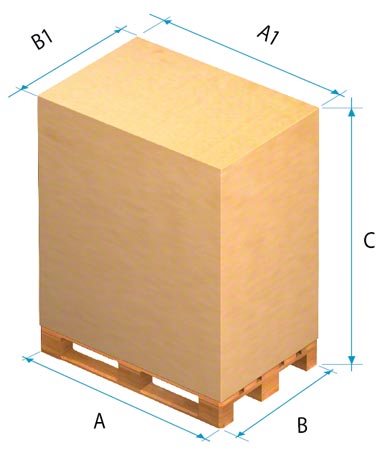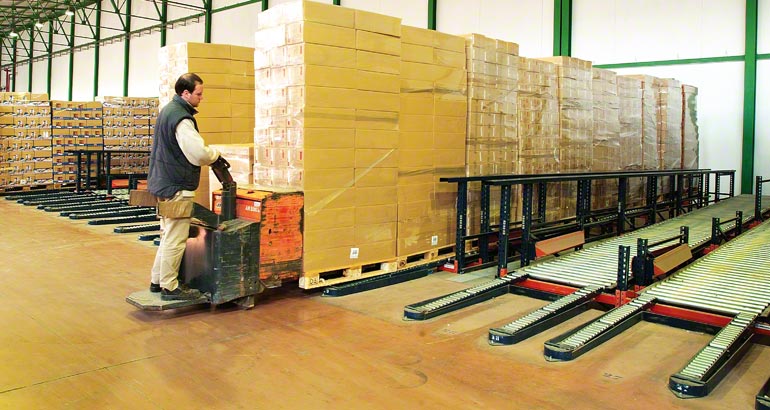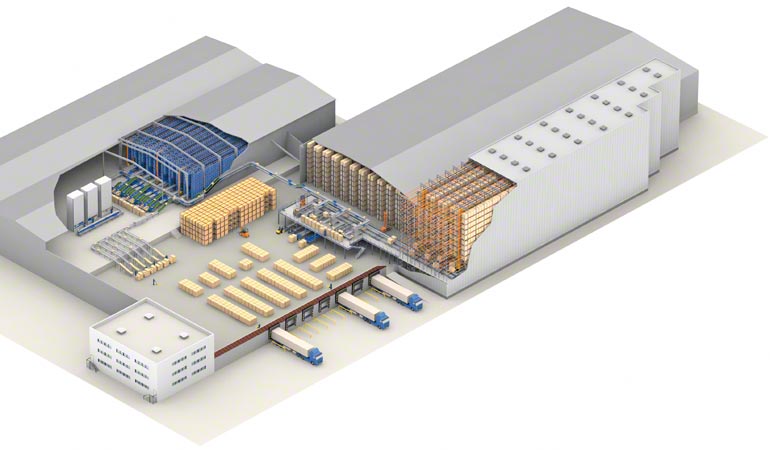A well-designed Automated warehouse or non-automated installation must be capable of performing the warehouse tasks and functions summarised below:
- Reception of all products involved in the industrial activity of the company that owns the warehouse
- Carry out immediate quality controls
- Control and inventory of the stored products
- Correct storage of the goods
- Preparation of orders to be sent to regional warehouses, customers, or both
- Rapid dispatch of orders
Reception of all products
To correctly receive all the products that comprise the industrial activity of the company that has built the central warehouse, a series of initial tasks must be carried out to determine the mechanical, personnel, and computing resources required.
The first step is an exhaustive analysis of the products to be received at the centre. This analysis must take into account the size and weight of the unit loads, the consistency of any packaging used, the arrival frequency of each material, and the quantity of goods received in each delivery.
Weight and size of products to be received
The analysis of these two factors determines the requirements to be fulfilled in terms of the goods received, the type of machines used, and their load capacities, which will not necessarily be the same as those used later in storage racks. It must be ensured that the machines used in the storage area are suitable to receive the goods in question and, if possible, for their dispatch as well.

Measurements to keep in mind for palletized goods
The goods received can be of different shapes, sizes, and weights. Indeed, this is almost always the case: the more varied the supply sources, the more commonly this occurs.
One of two situations normally arise: either all of the units are of the right size and shape to be stored directly, or many do not and need to be modified prior to being stored.
In both cases, the central warehouse must be ready to receive, prepare and store any type of goods. Therefore, it must have one or more docks, handling devices for unloading trucks, a reception area and, when necessary, a preparation area.
Mechanical means used for loading and unloading
The mechanical devices or means that can be and are often used to load and unload goods are pallet trucks, stackers, and counterbalanced forklifts.

A food business that focuses on pastries, breads and baked goods
Instant quality control
Quality control in a central warehouse must be limited to checking that the contents of a container in which the product is received match the actual container.
To facilitate this operation, unit loads must be accompanied by a delivery note that sets out the characteristics of the product received, its trade name (where applicable), and the number of units contained in each container or package (for example, in each pallet, container or box).
With this delivery note, the personnel who receive the goods must carry out selective sampling, opening a random package—if necessary—and checking its contents. This is done to check both the quantity and quality of the delivery.
A second aspect of quality control is checking that the container is strong enough to withstand the anticipated storage time and conditions. This is the point when the packaging is modified to adapt it to the characteristics of the warehouse, where required. This is required, above all, when a warehouse receives goods from various sources or suppliers.
Control and inventory of the products stored
As soon as quality control has been completed, the products are recounted. Once this has been done (and never before), the data are entered into the central computer. The reception department must have one or more terminals, so that if any discrepancy is detected between the goods delivered and the accompanying delivery note, immediate notification can be sent to the manufacturing center or the corresponding supplier.
Once receipt of the load has been recorded in the computer, the computer must provide the precise slot assigned to each unit, in accordance with the pre-established warehouse program.
When dispatching the goods this operation is carried out in reverse, with the central computer providing notification of the removal or exit of the corresponding units. The management system can then record the slot as empty and assign it to a new load.
This departure of goods must be recorded once the operation to remove the goods has actually taken place. Although the computer generates a delivery note, the position is still occupied from the time this document is issued until the load is actually moved from its position.
Therefore, if the goods are considered to have left when the delivery note is produced, the system could record this position as being free and assign it to a new load. However, since the load has yet to be picked, the operator could find that the space is still occupied, a situation which could occur if goods enter and leave at different speeds. To avoid this, the computer does not record the position as empty until the operator has picked the unit and this has been communicated to the system. The use of a suitable WMS guarantees all the processes involved in this point, and avoids this type of potential error in the management of the positions.
Proper storage of goods
Central warehouses must have the necessary mechanical devices in sufficient quantity to store goods correctly. If goods are received on pallets, the company must have one or more of the described handling resources or devices so they can handle these goods comfortably and safely, and insert them to the storage area.

Central warehouse with the handling equipment it needs to move loads
If, however, goods are received in bulk, not only is it necessary to have the resources required to move them, but also at times to have the tools or machines to package them. This can involve the use of hoppers, buckets or other suitable mechanical elements, such as skid steer loaders or even front loaders if the volume and characteristics of the goods so require.
In general, it is impossible to correctly store goods and receive a good financial return and efficiency, if a facility does not have the appropriate physical, personnel, and material resources.
Preparation of orders for regional warehouses
As noted at the beginning of this article, one of the main functions of a central warehouse is to act as a reserve for regional or local centres. As such, one of its primary tasks is to prepare orders requested by these centers. This operation can be done daily, weekly, monthly, or bi-monthly (or even less often), depending on the required frequency, the products being handled, and their size.
The following paragraph discusses the different systems and methods available for preparing orders. All of these are designed for specific circumstances, so their use is based on adapting to the specific needs of each company.
It should be noted at this point that for a central warehouse to be efficient in preparing orders, it is essential to have areas set aside for this activity on racking units or on the ground. For this, it is crucial to have appropriate storage racks.
Normally, orders must be prepared in a central warehouse on the ground or through automated or semi-automated systems, or at least it must be planned this way. This offers greater storage capacity and better ease and speed in the operation.
The reason for these two advantages is due to two main factors:
- Firstly, it offers the option to completely fill the spaces in the racking units, which obviously offers more storage capacity than preparing orders on racking units, since the space or slots set aside for this purpose are mostly half-empty.
- Secondly, the floor is the ideal level for operators to perform these tasks, so there is an improvement in their performance. This brings with it the ease (fewer errors) and speed mentioned earlier.
In addition, preparing orders using automated or semi-automated systems reduces the time required. However, to achieve the best possible performance orders need to be properly programmed; therefore, it is very important for these to involve complete unit loads whenever possible. Another factor that influences speed and efficiency is the ability of the central warehouse to be constantly aware of the requirements of the other points in the chain and to anticipate their requests as far in advance as possible.
How can this be predicted? The only efficient way to do this is to have all the relevant information. The faster and more accurate it is, the better the results will be. Therefore, it is vital to establish real-time communication between all the links in the chain, from the most remote point of consumption (for example, the business that sells the items), to the central computer of the production or picking point.

Functions carried out in a central warehouse
One model for linking these points that generate information is as follows: communication between the business and the controlling warehouse takes place on-line via computers. The link between the controlling warehouse and the order picker takes place from operator to computer through a scanner that communicates using radio waves. Finally, communication between the controlling and central warehouses takes place computer to computer, again, on-line.
There are several variations of this system and other alternatives exist as well. Companies that specialise in information technology are best-suited to planning and designing the communications required. In addition, to ensure that everything remains under control it is vital to have a good warehouse management system (WMS).

Rapid dispatch of orders
The time required to dispatch orders is vital to prevent delays and disruptions in distribution chains. As a result, one of the functions of a central warehouse is to perform this operation in a prompt manner.
Speed in dispatch operations is simply the product of the proper organisation of all of the aspects explained previously. If all of these tasks are performed as well as possible, the dispatch of orders is simplified and accelerated.
In contrast, if there are hold-ups and bottlenecks at points earlier in the process, then the dispatch of orders becomes chaotic and slows down. For this reason, it is essential that operations in the warehouse be well-coordinated. This is the most important part of the warehouse manager’s job.
